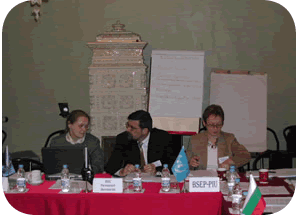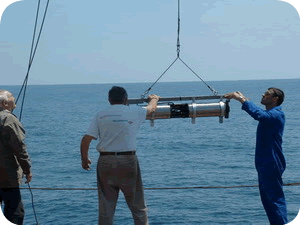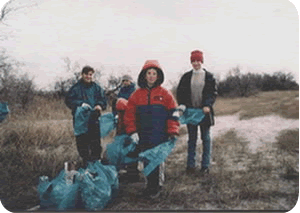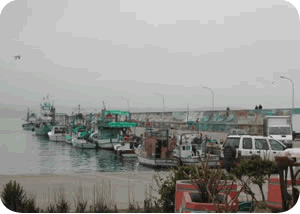|
In summary, the implementation of Phase 1 activities has progressed as follows:
| Objective 1: Support the integration of a sustainable Secretariat for the Bucharest Convention |
|
 |
|
Support has been given to the work of the Black Sea Commission's Advisory Groups through project staff and consultants. A survey was undertaken to evaluate the data gathering, assessment and exchange capacity and needs of Advisory Groups and Activity Centres. The institutional set-up of the Black Sea Commission’s framework is strengthened by the involvement of additional resources both human and financial. A task force (DABLAS Task Force) was established as a platform for common decision making and encouraging investments for environmental protection, in particular for reduction of eutrophication. BSERP participates in the process. |
A Joint Technical Working Group was also established with the mandate to develop harmonised monitoring systems, common assessment of the ecological status of inputs of nutrients and other hazardous substances, compatible reporting formats for input loads and the assessed ecological status, and formulate of appropriate measures to limit discharge of nutrients. In relation to the production of public awareness material, the PIU has been responsible for publishing the ‘Popular version of the Blacks Sea SAP’ in Bulgarian, Turkish and, Romanian, languages (English, Russian and Ukrainian were published previously). The newsletter ‘Black Sea Shared’ was also published in English and posted on web in all local languages. A table-top calendar for the promotion of the Black Sea Environmental programme and introducing partners in the process was published for 2003. A reference book for coastguards, fishing communities is currently under preparation. A web page for the project had been developed and upgraded continuously, providing information on project related activities and a modern means of communicating with partners.
| Objective 2: Regional actions for improving LBA legislation to control eutrophication and for tackling emergent problems |
|
An in-depth study and stakeholder consultations at the national and regional levels by the UNEP/GPA team on existing legislation, policies and practices, and identification of gaps and prospects for change was successfully carried out in Phase I of the BSERP. Before suggesting commitments for the region and individual countries, the analysis and planning process was undertaken by the UNEP/GPA, taking full account of economic, social, and political realities of the region such as the EU accession. This in-depth study was completed also in Phase I. Further cooperation on the initiatives of the EU has been coordinated for the latter half of Phase I and for Phase II with the DRP. Furthermore, a study of emergent issues in the Black Sea and their social and economic root causes based on application of the GIWA methodology was conducted with support from the UNEP/GIWA team.
| Objective 3: Assist countries to improve their knowledge of the process of eutrophication in the Black Sea |
|
 |
|
An Advisory Board composed of select scientists from coastal countries was established with a view to prepare the research programme for the International Study Group (ISG). The Advisory Board evaluated 79 international proposals. Selected representatives of the chosen research projects met in January 2003 for the 1st meeting of the ISG in order to prepare the first draft of the research plan. Three separate research cruises were agreed upon and planned by the ISG in detail. Other research activities conducted in Phase I included: |
(i) the extended monitoring of nutrients (organic and inorganic) and hazardous substance inputs to the Black Sea from the Danube river, (ii) remote sensing (historical and current) using SeaWifs in combination with the research surveys to determine the necessary algorithms required to accurately calculate the level of chlorophyll a (phytoplankton growth) by satellite, add (iii) shore-based investigation of macrophytes (incl. workshop and training programme for regional representatives). The first of the research cruises (benthic survey) was carried out successfully during September/October 2003. A pelagic research cruise planned for September/October was carried out in March/April 2003 (Phase 1). Two further cruises are planned in Phase II (summer and winter 2005).
| Objective 4: Introduce new sectoral policies and laws, and a system of process, stress reduction and environmental status indicators for monitoring the effectiveness of measures to control eutrophication (and harmful substances where appropriate) |
|
 |
|
The project suffered a delay in reaching an agreement on the methodology to be applied for analysing the relevant economic sectors and formulating measures for the reduction of nutrients and hazardous substances. Implementation of this activity was revised in late 2003. A number of interventions were untertaken during the latter part of Phase I and early Phase II. These included an agreement with the DRP on joint project implementation and the set up an institutional framework of the project implementation, which is tol strengthen the present cooperation and eventually lead to setting up of national and coastal inter-sectoral committees. |
Environmental status indicators, as agreed by the Black Sea - Danube Joint Technical Working Group (JTWG), were introduced to different Advisory Groups of the BSC for their review and feedback. The BSC Secretariat subsequently elaborated draft indicator-based reporting formats for continuous formal reporting to the BSC by the riparian countries. The BSERP provided support to the BSC in implementing of the reporting process and developing a proper storage and retrieval tools as a part of the Black Sea Information System (BSIS). Along with this, the BSERP also conducted a 10-year historical data (environmental and socio-economic) collecction/compilation exercise, which will be used for setting the background and justifying the validity of the final set of indicators. The BSERP on its part has developed a relational database and tools/interfaces for data manipulation.
With the support of the BSERP, the basic approach for the Integrated Monitoring and Assessment Programme for Black Sea Commission (BSIMAP) has been established by the Permanent Secretariat of the BSC. A pilot monitoring programme for environmental status indicators, as agreed by the JTWG of the BSC and the ICPDR, was designed and successfully completed. The environmental status indicators are currently being assessed by the PS and PIU for their ‘fitness-for-purpose’ in the Black Sea region.
| Objective 5: Support the Commission in their periodic review of Adaptive Management objectives |
|
This activity in Phase I is represented by cost-benefit analysis of the national strategies for reduction of nutrients and hazardous substances. Since the national strategies will not completed until midway through Phase II (in association with the DRP), this activity is planned accordingly.
| Objective 6: Assist the public in implementing activities to reduce eutrophication through a programme of grants for small projects and support to regional NGOs |
|
 |
|
In relation to the Small-Grants Programme (SGP), 17 projects totalling 320,000 USD were sub-contracted in December 2002-January 2003 with completion dates of April 2004. A strategy for the second call was drafted and is currently under discussion. Following its adoption (by the GEF, UNDP, as well as by the Black Sea Commission and a wider public), a second call will be made in mid-2005.
A directory of Black Sea wetlands was prepared by international (Wetlands International) and local (NGOs) partners together with detailed recommendations on wetland conservation. |
A number of activities were held by NGOs on the International Black Sea Day, supported by the PIU through press releases issued in all local languages, the newsletter published in English and posting on web on local languages. Preparations are also under way for making a video movie to acknowledge local populations with their ecological and economical significance. In relation to environmental education, measures were instigated to enrich the local character of the scientific contents of an education draft study pack. This was carried out to better coordinate with national education authorities operating in the region. The education study pack will be finalised and published in Phase II.
There was a delay in the operation of the Black Sea Train Sea Coast course development for agricultural management of nutrients in coastal regions. Completion of course planned for 2005 with first delivery in the Black Sea coastal region.
| Objective 7: Formulate proposals for market-based or alternative economic instruments for limiting nutrient emissions and establish private-public sector partnerships for environmental protection in the Black Sea |
|
The methodology for environmental and economic analysis developed during Phase I and will be further developed in Phase II in association with the DRP. A detailed analysis of existing international and regional economic instruments for nutrient reduction was successfully carried out during Phase 1 of the BSERP. Activities have also been initiated in a number of riparian countries in the field of public-private sector partnership. The first phase has concentrated on (i) the analysis of the relevant stakeholders in the Black Sea riparian countries, (i) the legal base in each country and (iii) recommendation for future partnerships.
An updated priority investment portfolio prepared as part of (by technical and financing sub-committees) DABLAS Task Force established by the BS and Danube Commissions and supported by the EC is being jointly prepared by the parties involved. A separate activity was also initiated by the BSERP to determine the potential of the local and/or regional financial intermediaries as a means of channeling funding to small/medium sized bankable projects related to nutrient limitation and habitat restoration.
| Objective 8: Fisheries exploited within its maximum sustainable yield and incorporating measures to protect ecologically sensitive areas |
|
 |
|
A background document, prepared with support from the BSERP for the Activity Group on Fisheries and Other Living Marine Resources (FOMLR), suggested the main management and conservation issues that need to be incorporated in a regional fishery management strategy. With a view to study the status and trends, a regional data compilation and evaluation exercise was undertaken. Results were evaluated and a realistic set of indicators for ecosystem based fisheries have been devised. As a pilot activity, demersal resources were studied in depth. Coordination with international expert institutions (FAO-GFCM) for the inclusion of a regional coordinated stock |
assessment in GFCM work-programme was made and a proposal was drafted for submission by countries’ fisheries authorities to FAO. A guidebook on Responsible Fisheries in the Black Sea to be published in all local languages and widely distributed to the local managers, fishermen and public is under preparation. |




